Motorsports
Kevin Harvick’s 3 tips for winning at Phoenix Raceway
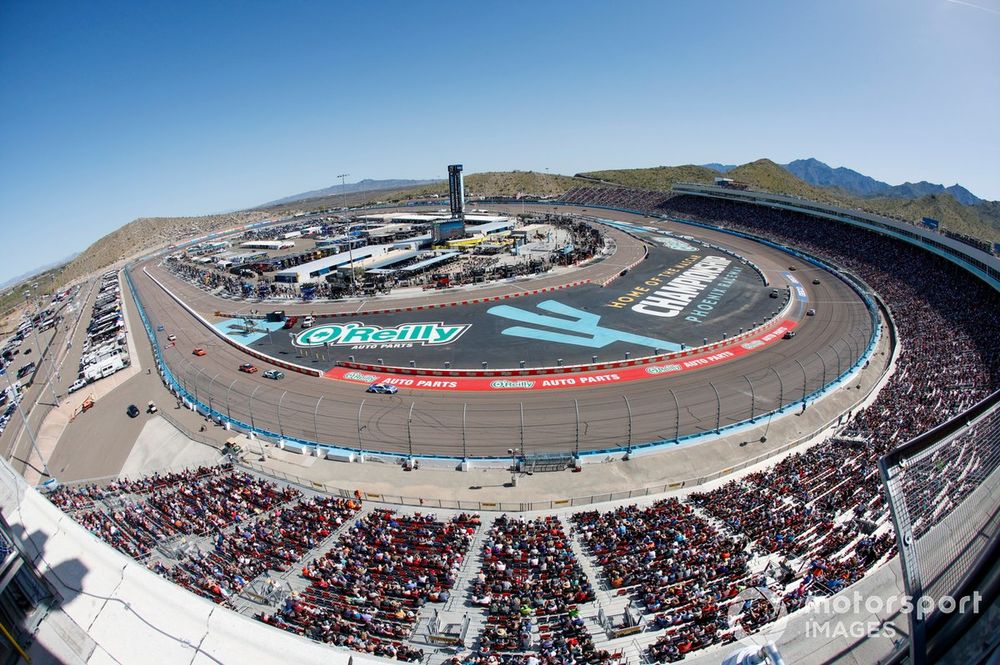
In modern NASCAR, champions aren’t crowned until the last lap of the last race of the season. Four drivers (from three super teams) arrive at the season finale with one last chance at the title — and the highest finisher wins it all. This weekend, Ryan Blaney, Joey Logano, Tyler Reddick, and William Byron will battle to see who comes out a champion. And they’ll go to battle at Phoenix Raceway in Avondale, Arizona.
Phoenix is arguably the most important track in NASCAR, if only because it’s where the champion’s been crowned since 2020. The 1.0-mile asphalt oval isn’t without its quirks and specific strategies, either. That’s why I called up the winningest Cup Series driver ever at Phoenix, Kevin Harvick, who racked up nine wins across 21 years.
So, how do you win Phoenix and the NASCAR Cup Series championship, in Harvick’s mind?
“Well, that’s a loaded question,” he said.
Harvick may have recently retired from full-time driving to become a commentator on races for FOX Sports (and host a podcast host with the network “Kevin Harvick’s Happy Hour“), but the retired champion kindly explained, in champion-level detail, exactly what it takes to leave with the trophy.
A quick Kevin Harvick history lesson on Phoenix Raceway

Phoenix Raceway
Photo by: David Rosenblum / NKP / Motorsport Images
NASCAR hosted its season finale at the 1.5-mile Homestead-Miami Speedway oval in Florida before the grand finale moved to Phoenix in 2020. NASCAR has said it likely won’t stay there forever, but hasn’t shared any concrete plans about what’s next.
Phoenix is a “huge part” of Harvick’s career — from the old days to the modern ones, after the Cup Series introduced its new “NextGen” race car and essentially flipped the track layout.
“I grew up on the West Coast, and Phoenix was kind of our Super Bowl for the touring divisions throughout the years,” Harvick said. “But that Phoenix is not the same Phoenix we see today. [The track] was very uniquely redesigned to have a stadium feel to it.
“The start-finish line used to be on what is now the back straightaway. The front straightaway was redesigned so fans could see it from the infield. You’re really in position to see great finishes, which we have seen. And what is now the front straightaway was banked so you could elevate and see the cars from other places on the racetrack.”
Harvick categorizes Phoenix in three ways: short, flat, and “known for its restarts.” There’s asphalt from the outside wall to pit-road exit, leading cars to fan out six-wide on restarts. Phoenix also isn’t a standard oval. It has four turns and a front-straightaway dogleg that’s not labeled as an official corner, which is where those restarts occur.
Phoenix hasn’t been universally loved as the season finale — especially with barn-burners at Homestead — because short tracks have been a struggle with the NextGen car. But Phoenix has all the glitz of a season finale on the surface, and all the challenges of one underneath.
Those challenges start, in some ways, at the end.
Harvick’s Phoenix Tip #1: Stay loose
Phoenix is a track where getting the last laps right is maybe more crucial than nailing the start.
“You need to qualify good, but I don’t think that’s the end of the world. If your car’s going to win, you need to be good on the long run. You have to have a car that you can adjust on throughout the day. How it starts isn’t how it’s going to need to finish.”
In NASCAR, races have “long runs” and “short runs.” Cup cars can last 95 laps on one tank of fuel, and the race itself lasts 312. A short run at Phoenix maxes out at about 30 laps in the Cup car owing mostly to tire degradation: the rubber breaks down intensely over the first 30 laps before plateauing and wearing much more slowly over the next 70 laps or so.
“Kevin found speed by being fastest during that plateau area,” explained one race engineer I spoke with. “Since lap times degrade very little during that section of the run, it’s all about consistency.”
But the Phoenix finale is about more than consistency. It’s about anticipation.
William Byron and Kevin Harvick lead the charge in 2023 in Phoenix
Photo by: Matthew T. Thacker / NKP / Motorsport Images

The race starts midday and transitions into dusk, so the car has to be set up for the lower temps of a desert sunset. The track’s surface changes with the heat loss and the rubber buildup from tires, meaning teams have to find the right balance between loose (rotates too much, like it’s on ice skates) and tight (doesn’t turn sharply enough).
“We saw it last year,” said Harvick. “We saw the racetrack really change. A lot of the cars that were super loose to start the race wound up being the really good cars at the end, because the track tightens up as the day goes on. I think you just have to run the car as loose as possible, and sometimes a little looser than you like it, in order to keep the turn in the car throughout the whole day.”
Harvick’s Phoenix Tip #2: Master the restarts

A patented Phoenix restart in 2019
Photo by: Russell LaBounty / NKP / Motorsport Images
Phoenix restarts are one-of-a-kind. NASCAR’s rolling-start restarts bring cars two-wide toward the green flag. But in Phoenix, cars immediately dive left to drive the shortest distance possible through the dogleg, fanning out five- and six-wide.
There’s just one problem: the yellow line marking the “bottom” of the track, where it transitions from banked corner to flat apron, means not everyone gets to where they want to go.
“The hardest part about the restart is not mistiming it, because you can’t go below the yellow line until you get to the start-finish line,” Harvick said. “The first thing everybody wants to do is go left, so from a driver’s standpoint, you just have to be aware of where that start-finish line is in order to not get a penalty.
“But you can’t be conservative. You have to go as low as you can go, because if you don’t, somebody’s going to go lower. We don’t see a ton of wrecks, but the ones that do happen are usually from somebody being slow to react or not going all the way to the bottom. Somebody shoves their nose inside of them, and next thing you know, somebody hits the inside wall.”
A driver’s position in the field can also make or break their restart in Phoenix. NASCAR restarts typically have about 40 cars in two lines of 20, and the lead car accelerates in a “restart zone” before the green flag. But with the Phoenix reconfiguration, a lot of the field is still in the final corner when the leader accelerates.
“Being able to accelerate in the corner is not easy,” Harvick said.
Then, there’s the physical toll those left-hooks take. Drivers slam onto the flatter apron from the banked racing surface, and they don’t have cushy suspension to protect them.
“When I drove the NextGen car, the last thing I wanted to do was go on the apron,” Harvick said. “It’s the most uncomfortable ride you could possibly imagine, because the car bottoms out. It’s a jarring blow every time.”
Harvick’s Phoenix Tip #3: Brake hard, drive harder
Restart or not, drivers have to settle into a rhythm around Phoenix. That means carrying as much speed into and out of the corners as possible.
“The first thing that I always try to tell people is: You have to get the braking,” said Harvick. “I think being able to still get a nice shape into the corner, but drive the car into the corner as hard as you can, is where we always made up a lot of time.”
Harvick also said drivers “can’t be locked into one line.”
“If everybody’s on the bottom of the racetrack, you’re never going to pass them,” Harvick said. “That was one thing that always made us good with this style of racetrack: the fact that you had to go searching around for what you needed to be doing.”
Harvick was also good at Phoenix because “you trail off the brake and go right back to the throttle, and there was not a lot of out-of-the-throttle roll time.” It suited his driving style, and if he nailed the transition from brake to throttle, he knew it was a good lap.
“The first cue, for me, was when I would let off the brake: what the front tires would do, and how long it took for those front tires to grab and go the other direction,” Harvick said. “The second cue was: How hard could I put the throttle down on the exit of the corner?”
Because Phoenix is a different shape on each end of the track, the technique is different in Turns 1 and 2 than it is in Turns 3 and 4. (And often, Harvick said, if you do well in Turns 1 and 2, you’ll overdrive 3 and 4. It’s hard to get a perfect lap in.)
“I always found that Phoenix was a place where, in Turn 1, you could turn the steering wheel a lot harder than most places,” Harvick said. “That second tug on the wheel was something I felt like was an advantage for us, being able to still have your car turn through the middle of one and two — and as soon as it did turn, being able to go back to the throttle and drive up off the corner.”
In Turns 3 and 4, Harvick had his eyes on one thing: the yellow line.
“For me, Turn 3 was a corner that I wanted to be able to drive the car in straight,” Harvick said. “I wanted to have my eyes towards the inside wall to pick up that yellow line, because I felt like it was kind of like a trough. The left-front tire loves that little line in the trough.
“If you could hit it right with your left-front, then you could lift off the brake and start to apply some partial throttle. Then [you could] have your eyes up and drive straight [toward] the start-finish line. I think you’re going to win the race on the bottom in 3 and 4.”
Motorsports
Elite company: Joey Logano sits down to talk about his third NASCAR Cup Series title
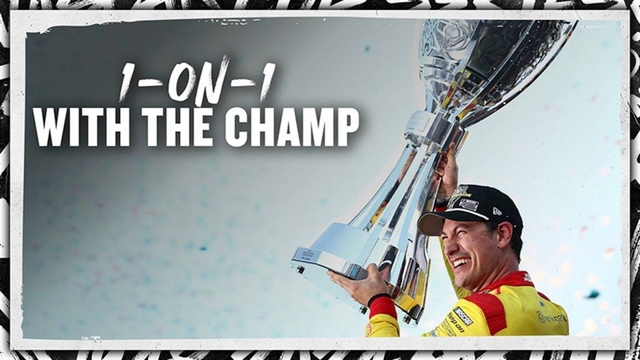
Continue reading with advertising …
… or with a subscription
Visit motorsport.com as usual with advertising and tracking. You can revoke your consent at any time via the data protection page.1
Use motorsport.com without any advertising banners, personalized tracking and commercials for a small fee.
More information about advertising and tracking in our Data protection notice, the List of our partners and in Data protection information center.
Already a subscriber?
Log in here
Motorsports
Why retiring Aleix Espargaro can take pride in his MotoGP achievements
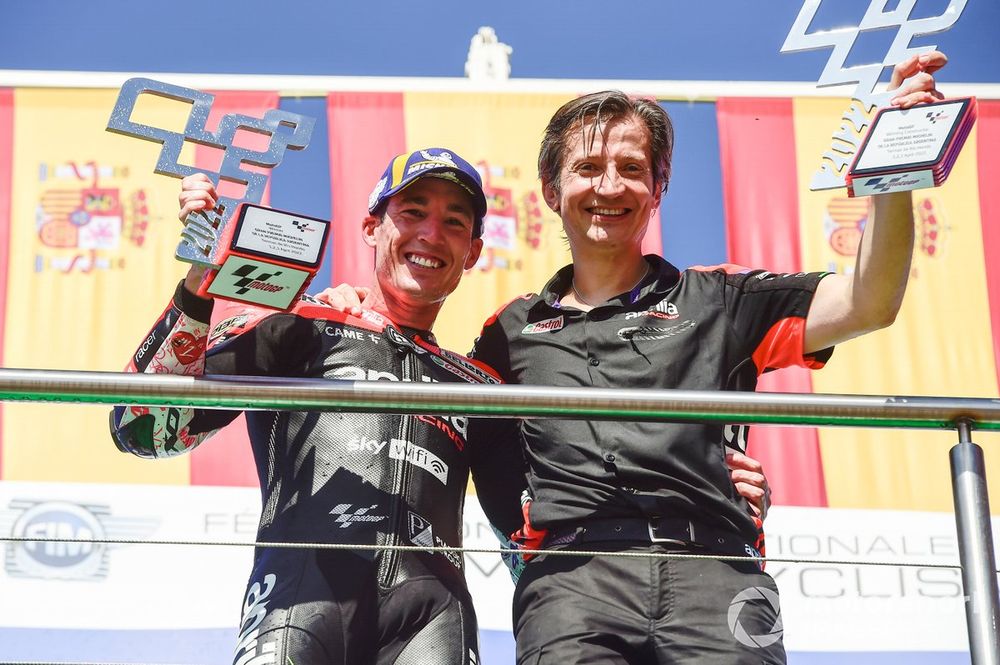
When Aleix Espargaro steps off his Aprilia RS-GP for the final time at this weekend’s Barcelona Grand Prix finale, he will be able to look back at a long and ultimately successful MotoGP career that few – including the man himself – are likely to have predicted unfolding the way it did.
In fact, celebrating his career path in grand prix racing as one no rider has traversed before him and probably never will is arguably the greatest tribute one can pay to the 35-year-old.
Set to retire with 255 premier class grand prix starts to his name, in terms of longevity at least, only Valentino Rossi can lay claim to having started more races once Espargaro bids adios to the grind of 20 international events a year.
And – cliche though it may be – if Espargaro’s career was a cheese, it certainly went on to mature into a fine blue. Indeed, with one round still to go, Espargaro will depart having tallied at least three MotoGP victories, plus two sprint race wins, 11 podiums and seven pole positions.
Moreover, not just for himself, but that maiden success at the 2022 Argentinian GP will rank as one of the series’ most memorable modern-era successes destined to be raised in fondness long after his final chequered flag.
Granted, while there is some backhanded cynicism to go with the addendum of his first victory coming at the 200th attempt in the premier class, the belatedness also speaks of a rider whose dogged attitude towards development and an ability to rally a team around him succeeded in keeping him on the grid when many more decorated contemporaries came and went.
Espargaro belatedly broke his duck at the 2022 Argentina GP, reaping the rewards of his lengthy relationship with Aprilia
Photo by: Gold and Goose / Motorsport Images

Espargaro made his 125cc debut in 2004 and ascended to 250cc in 2006 before a full MotoGP debut came in 2009. Save for a season of Moto2 in 2011, he has remained on the MotoGP grid for an impressive 15 years. Indeed, there is some butterfly theory you could apportion to Espargaro being somewhat fortunate that a MotoGP career was even possible at all, even if being in the right place at that right time preceded a lengthy stint in the wrong one.
Grappling for grip on a junior development path that counted the likes of Marco Simoncelli, Alvaro Bautista, Hector Barbera and Hiroshi Aoyama among him in the quarter-litre division, Espargaro’s results in both 125cc and 250cc were solid, if not sparkling. Though a regular top 10 finisher, a personal best of fifth after four full seasons didn’t present him as a future MotoGP race winner, so much so that he was left without a 250cc seat altogether coming into 2009.
But being consigned to a Moto2 development rider role would go on to work in his favour. Espargaro was called up when Pramac Racing required a substitute for the injured Mika Kallio at short notice ahead of August’s Indianapolis GP.
Espargaro’s legacy is a reminder of what perseverance and loyalty can achieve
The limitations of what was then a modestly competitive Ducati machinery notwithstanding, Espargaro acquitted himself well during a four-event stint, finishing and scoring in each. It led to a full-time deal for 2010 that set him on a long-term MotoGP career path that may not have ever come had he not been sidelined in the first place.
Leaving MotoGP with victories to a name will always be a credit to any rider. But by achieving his on an Aprilia package that for many years prior had been battling for relative scraps, Espargaro’s legacy is a reminder of what perseverance and loyalty can achieve.
Scouted by Aprilia for 2017 MotoGP season for his experience, Espargaro arrived at a team still finding its feet two years on from its return to the top flight after an absence of more than a decade. While Espargaro’s entry route from Suzuki – which also beat the comeback trail to MotoGP in 2015 – ensured he was familiar with a native project, at Aprilia he’d inherited one making only modest progress by comparison.
The combination of Aprilia splitting its project between being partly in-house, partly choreographed by Gresini Racing, machinery that had evolved awkwardly from a WorldSBK platform and questionable reliability would send it down several erroneous paths of development.
Espargaro was in the right place at the right time to get his MotoGP shot on a Pramac Ducati in 2009, and parlayed it into a lengthy career
Photo by: Martin Heath / Motorsport Images

It was a credit then to Espargaro for keeping morale high during what would become a loyal eight-season stretch with Aprilia, for better and for worse. Having Espargaro grow with the project would prompt Aprilia to retain faith in the Spaniard to see it through, a vote of confidence that helped him return incrementally better results with each passing season.
So while Espargaro might not have been the obvious candidate to become a contender for race wins for much of his MotoGP career, by the time Aprilia had fettled the RS-GP into a competitive package, it’s hard to imagine anyone other than Espargaro achieving the best results on it.
A run to fourth overall during a 2022 season that delivered six podiums, including that popular maiden victory at Rio de Termas Hondo, is a crowning achievement in itself. But for Espargaro it comes with the thick slab of pride that comes from not only proving his credentials as an elite MotoGP rider, but doing so on a machine he’d curated from years of lengthy and often difficult development work.
In a series where most riders set out to traverse an upward trajectory towards a well-established front-line team in their pursuit of success, what sets Espargaro apart is that he’d take an entire manufacturer and team with him too.
As a new chapter as a development rider for Honda awaits, Espargaro will look over at Aprilia knowing he was the one to lay the foundation from which successors Jorge Martin and Marco Bezzecchi will springboard from in 2025. And that is something to be especially proud of.

Espargaro can bow out this weekend feeling rightly proud of his career
Photo by: Gold and Goose / Motorsport Images
Motorsports
How Martin will follow in Rossi’s footsteps if he wins the 2024 MotoGP title
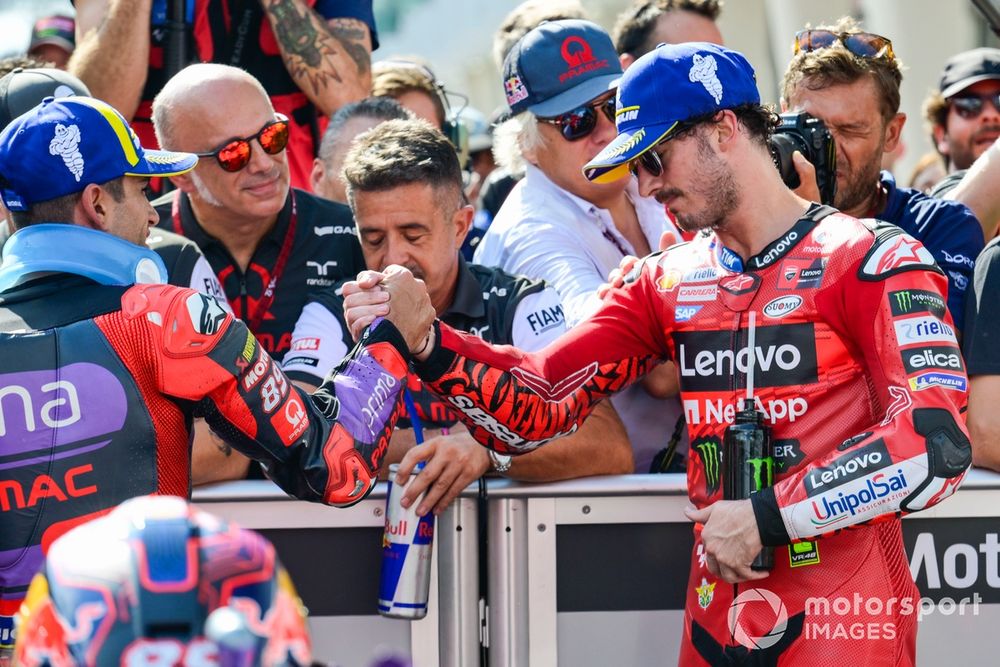
If Jorge Martin is crowned the 2024 MotoGP champion in this weekend’s Barcelona Grand Prix finale, he will become the first rider to win a premier class title with a satellite team since Valentino Rossi 23 years ago.
Having led the championship for almost the entire season, the Pramac rider holds a substantial 24-point lead with 37 left available meaning he looks set to finally claim a maiden world title.
This comes after nearest rival Francesco Bagnaia, who has won the past two titles, crashed on his factory Ducati in the sprint race at Sepang before scoring just five points in the grand prix last time out.
Martin could therefore seal the championship as early as Saturday if he is able to extend his lead over Bagnaia by two points.
Having had to accept an agonising defeat to Bagnaia last season, a victory in this year’s ‘rematch’ will make Martin the first rider to win the world championship with a satellite team since the MotoGP era of the series began in 2002.
It is worth noting that Pramac did win the teams’ title last year with Martin and Johann Zarco, becoming the first satellite squad to do so in the entire history of the championship. But no one has won the riders’ crown while racing for a satellite team since Rossi achieved the feat in the 500cc class in 2001.
Francesco Bagnaia, Ducati Team, Jorge Martin, Pramac Racing
Photo by: Gold and Goose / Motorsport Images

Having already come close to beating Suzuki’s Kenny Roberts Jr to the crown in his rookie season in 2000 while riding for what was officially known as the Nastro Azzurro team, Rossi claimed the first of his seven premier class titles in dominant fashion the following season.
The Italian had to remain at Nastro Azzurro in 2001, since the factory Repsol Honda team already had Alex Criville and Tohru Ukawa on its roster.
But Nastro Azzurro was treated as a semi-factory operation and received equipment directly from Honda, while Rossi himself was supported by the crew that had worked with the legendary Mick Doohan until his retirement in 2000.
Still, his campaign went down in history, as he won 11 of the 16 races to outgun Yamaha’s Max Biaggi to the title.
Apart from Rossi, four other riders have won the 500cc title with a non-factory team, although in each case the outfit in question was treated favourably by its associated manufacturer.
The first rider to achieve that feat was Kenny Roberts Sr. The Californian, who had previously made a name for himself on dirt tracks, stole the show from Barry Sheene as a rookie for Yamaha’s American division.
Podium: winner Valentino Rossi, second place Alex Barros, third place Loris Capirossi
Photo by: Gold and Goose / Motorsport Images

Although he didn’t get the latest parts on his bike at the start of the season, the Iwata brand eventually started supporting him as the year progressed. He also won the title in 1979 while remaining at its American arm, before delivering the factory squad the title in 1980.
Two other cases of non-factory team riders winning the championship followed immediately afterwards. In 1981 and 1982, Marco Lucchinelli and Franco Uncini were crowned champions on a Suzuki RG500 entered by Nava Gallina – a team led by former grand prix rider Roberto Gallina.
The last rider to win a premier class title on a satellite bike before Rossi was Eddie Lawson. The Californian was also a special case, because he had already won three titles in 1984, ’86 and ’88 with the official Yamaha team.
In 1989, he switched to Honda, but with the Rothmans squad as the factory seats were already occupied by Wayne Gardner and Mick Doohan. However, a serious injury for Gardner at Laguna Seca prompted HRC to give more support to Lawson, who duly repaid the faith entitled him by beating Yamaha’s Wayne Rainey to the title.
Martin is now set to join this illustrious club of riders, pending the outcome of the Barcelona finale.
Motorsports
All F1 teams to unveil 2025 liveries at dedicated London O2 event
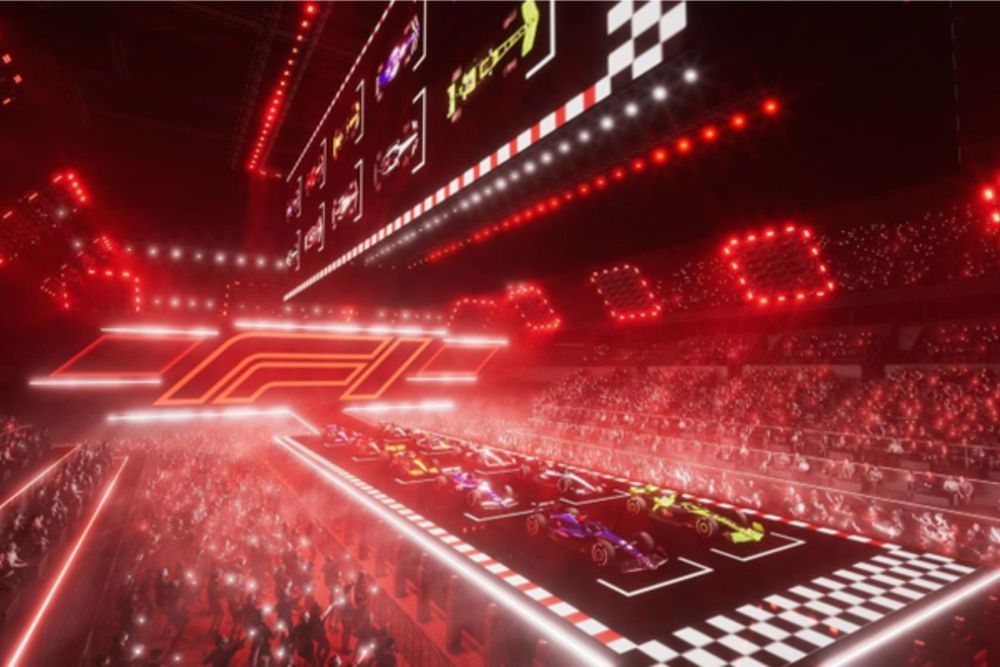
Formula 1’s 75th anniversary season will begin in unprecedented and unfamiliar surroundings as all 10 teams launch their 2025 liveries alongside one another at London’s O2 Arena on 18 February.
The event will bring together all 20 drivers and their team principals, giving fans a first look at how the F1 grid will look for the season-opening Australian Grand Prix on 16 March.
While some 2025 car designs are likely to still be under wraps before the show, the liveries will all be revealed simultaneously at an event led by BrianBurkeCreative – the company behind the opening and closing ceremonies at the inaugural Las Vegas Grand Prix a year ago.
Tickets will range from £58-£113 plus booking fee and go on general sale on Friday morning, with the promise of an “interactive event” including “interviews with key figures from the sport” with drivers and team bosses involved.
The event will also be streamed online and F1 President and CEO Stefano Domenicali is anticipating an evening to remember.
“For the first time we will bring together our fans, all 20 superstars of our sport and some very special guests to officially kick-off our new season and mark our 75th year of racing,” he said.
O2 launch event
Photo by: Formula 1

“With 2025 set to be a classic season following all the drama so far for 2024, this is a fantastic opportunity for fans of all ages to experience up-close the incredible entertainment spectacle that is Formula 1.”
Having worked on the events in Vegas, Brian Burke, the Creative Director for BrianBurkeCreative – who will work alongside Stufish Entertainment Architechs, DX7 Design and 1826 to put on the show – is looking forward to once again providing the F1 entertainment.
“It’s an incredible honour to continue to partner with Formula 1 creating new entertainment experiences, especially this brand-new launch event of the 2025 season celebrating the 75th anniversary of the sport,” he said.
“Through our collaboration with all 10 teams, fans can be assured we’ll be delivering a truly exciting live experience combining the unveiling of the new liveries, interviews with the biggest names in F1, and cutting-edge entertainment.
“It will be a never-before-seen event not to be missed!”
Motorsports
F1 race director Wittich steps down with immediate effect
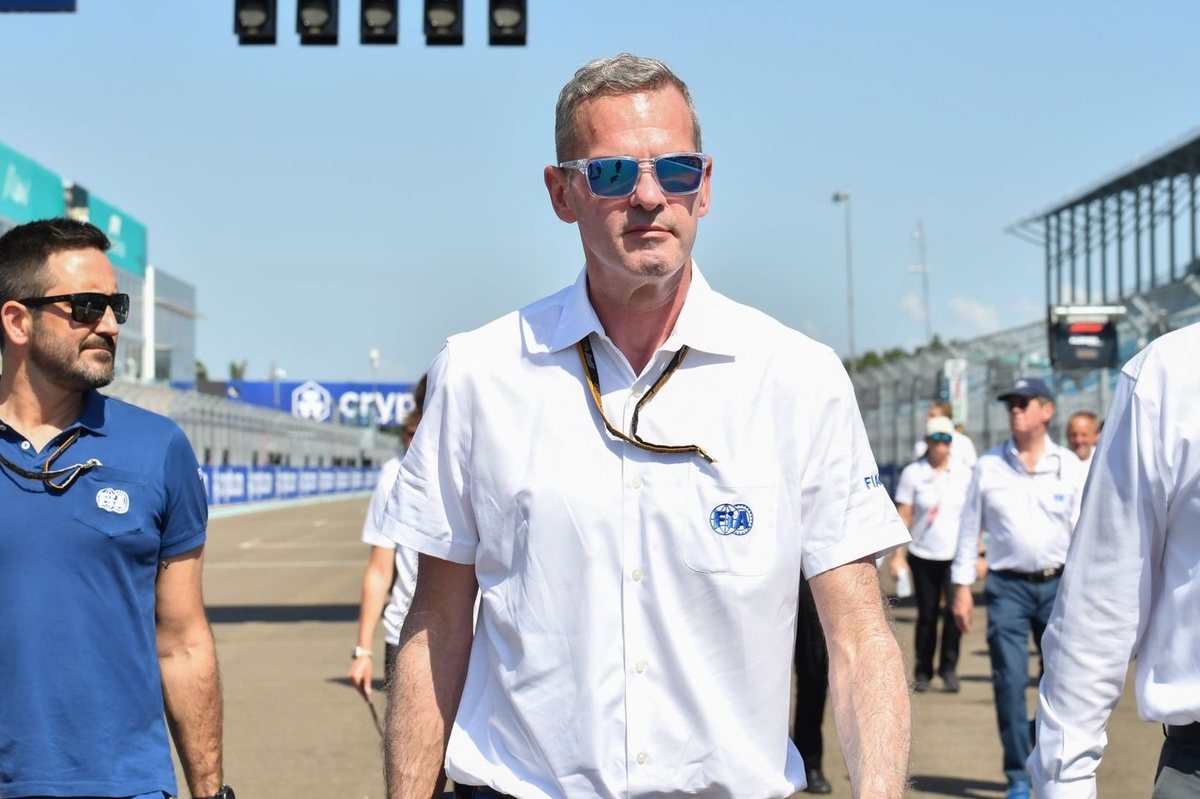

The FIA has announced Formula 1 race director Niels Wittich has left his role with immediate effect.
On Tuesday the FIA said in a statement that the German had left his position ahead of the Las Vegas Grand Prix to “pursue new opportunities”.
“The FIA can confirm that Niels Wittich has stepped down from his position as F1 Race Director to pursue new opportunities,” the statement said.
“Niels has fulfilled his numerous responsibilities as Race Director with professionalism and dedication. We thank him for his commitment and we wish him the best for the future.”
Portugal’s Rui Marques, who has acted as F2’s and F3’s race director for the past two years, will take over from Wittich from Las Vegas onwards.
“Rui Marques will assume the role of Race Director from the Las Vegas Grand Prix,” the FIA stated.
“Rui brings a wealth of experience having previously served as track marshal, scrutineer, national and international steward, Deputy Race Director and Race Director in various championships. Most recently, he held the position of Formula 2 and Formula 3 Race Director.”
Among other roles, Wittich has been F1’s race director since 2022, replacing Michael Masi after the controversial finish to 2021’s Abu Dhabi Grand Prix.
Wittich initially shared the role with FIA WEC race director Eduardo Freitas, before taking over the role full-time later that year.
Previously, the 52-year-old German was a race director in the German DTM championship.
Motorsports
Fallows steps down as Aston Martin F1 technical director
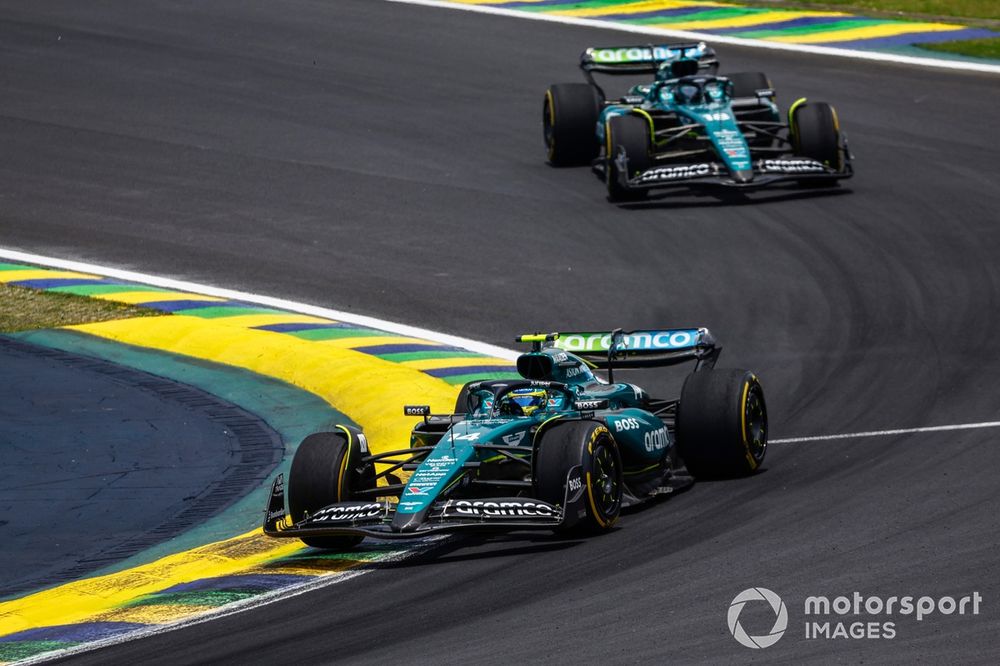
The Aston Martin Formula 1 team has announced Dan Fallows has stepped down with immediate effect from his role as technical director of the Silverstone squad.
Fallows joined Aston Martin in April 2022, taking up the job of technical director after a long stint with Red Bull, where he rose through the ranks to become Chief Engineer – Aerodynamics.
Under his watch Aston Martin enjoyed a brief growth spurt in 2023, taking eight podiums with Fernando Alonso aboard the AMR23. But Aston’s form then tailed off as rival teams caught up. This year it has been stuck in fifth place in the constructors’ standings as it struggled to develop its AMR24, which led to the team’s call to make a change to try and turn around its fortunes.
The team has now announced that Fallows has stepped down from his role as technical director with immediate effect and leave the F1 team, but he will remain active within the wider Aston Martin group in a yet-to-be-announced capacity.
“The Aston Martin Formula 1 Team and Technical Director Dan Fallows have today jointly announced that from November, Dan will no longer serve as Technical Director of the Formula One Team. Dan will remain with the Group,” a statement by the team said.
“In my time at Aston Martin, it has been a joy and a privilege to guide the technical team on their journey towards being race and championship winners,” said Fallows. “ It is time for me to pass on the baton, but I look forward to watching the team’s future success, which I am sure will come soon.”
Fernando Alonso, Aston Martin AMR24, Lance Stroll, Aston Martin AMR24
Photo by: Sam Bloxham / Motorsport Images

Group CEO Andy Cowell added: ‘I would like to thank Dan for his contribution to Aston Martin in the last two years. Dan led the team to the success of the AMR23 which secured eight podiums last season.”
As well as Cowell taking over from Martin Whitmarsh as CEO this year, the team has also headhunted legendary Red Bull designer Adrian Newey, who is set to start in March, as well as long-time Ferrari stalwart Enrico Cardile, who will also join in 2025.
Fallows was set to report to Cardile, who will join as Chief Technical Officer, but Motorsport.com understands the team hasn’t yet decided if Fallows will be directly replaced once its new hires are in place.
In the meantime, Fallows’ responsibilities will be absorbed by Aston’s current technical leadership, which includes deputy technical director Eric Blandin and Bob Bell, who holds the role of Executive Director – Technical.
Alongside Aston’s hiring spree, the squad has also moved into a brand-new headquarters opposite the Silverstone circuit this year, with a state-of-the-art wind tunnel on the way.
-

 Science & Environment2 months ago
Science & Environment2 months agoHow to unsnarl a tangle of threads, according to physics
-

 Technology2 months ago
Technology2 months agoWould-be reality TV contestants ‘not looking real’
-

 Technology2 months ago
Technology2 months agoIs sharing your smartphone PIN part of a healthy relationship?
-

 Science & Environment2 months ago
Science & Environment2 months agoHyperelastic gel is one of the stretchiest materials known to science
-

 Science & Environment2 months ago
Science & Environment2 months ago‘Running of the bulls’ festival crowds move like charged particles
-

 Science & Environment2 months ago
Science & Environment2 months agoX-rays reveal half-billion-year-old insect ancestor
-

 Science & Environment2 months ago
Science & Environment2 months agoPhysicists have worked out how to melt any material
-

 MMA1 month ago
MMA1 month ago‘Dirt decision’: Conor McGregor, pros react to Jose Aldo’s razor-thin loss at UFC 307
-

 News1 month ago
News1 month ago‘Blacks for Trump’ and Pennsylvania progressives play for undecided voters
-

 Sport1 month ago
Sport1 month agoAaron Ramsdale: Southampton goalkeeper left Arsenal for more game time
-

 News1 month ago
News1 month agoWoman who died of cancer ‘was misdiagnosed on phone call with GP’
-

 Money1 month ago
Money1 month agoWetherspoons issues update on closures – see the full list of five still at risk and 26 gone for good
-

 Football1 month ago
Football1 month agoRangers & Celtic ready for first SWPL derby showdown
-
Business1 month ago
how UniCredit built its Commerzbank stake
-

 Technology1 month ago
Technology1 month agoUkraine is using AI to manage the removal of Russian landmines
-

 Sport1 month ago
Sport1 month ago2024 ICC Women’s T20 World Cup: Pakistan beat Sri Lanka
-

 Science & Environment2 months ago
Science & Environment2 months agoMaxwell’s demon charges quantum batteries inside of a quantum computer
-

 Science & Environment2 months ago
Science & Environment2 months agoSunlight-trapping device can generate temperatures over 1000°C
-

 Science & Environment2 months ago
Science & Environment2 months agoA new kind of experiment at the Large Hadron Collider could unravel quantum reality
-

 Science & Environment2 months ago
Science & Environment2 months agoLiquid crystals could improve quantum communication devices
-

 Technology1 month ago
Technology1 month agoSamsung Passkeys will work with Samsung’s smart home devices
-

 Science & Environment2 months ago
Science & Environment2 months agoLaser helps turn an electron into a coil of mass and charge
-

 Science & Environment2 months ago
Science & Environment2 months agoQuantum forces used to automatically assemble tiny device
-
Business1 month ago
Top shale boss says US ‘unusually vulnerable’ to Middle East oil shock
-

 News1 month ago
News1 month agoMassive blasts in Beirut after renewed Israeli air strikes
-

 Science & Environment2 months ago
Science & Environment2 months agoWhy this is a golden age for life to thrive across the universe
-

 Technology2 months ago
Technology2 months agoRussia is building ground-based kamikaze robots out of old hoverboards
-

 Technology1 month ago
Technology1 month agoGmail gets redesigned summary cards with more data & features
-

 MMA1 month ago
MMA1 month agoPereira vs. Rountree prediction: Champ chases legend status
-

 Science & Environment2 months ago
Science & Environment2 months agoQuantum ‘supersolid’ matter stirred using magnets
-

 News1 month ago
News1 month agoNavigating the News Void: Opportunities for Revitalization
-

 News1 month ago
News1 month agoCornell is about to deport a student over Palestine activism
-

 Sport1 month ago
Sport1 month agoBoxing: World champion Nick Ball set for Liverpool homecoming against Ronny Rios
-

 Entertainment1 month ago
Entertainment1 month agoBruce Springsteen endorses Harris, calls Trump “most dangerous candidate for president in my lifetime”
-

 Technology1 month ago
Technology1 month agoEpic Games CEO Tim Sweeney renews blast at ‘gatekeeper’ platform owners
-

 Technology1 month ago
Technology1 month agoSingleStore’s BryteFlow acquisition targets data integration
-

 Business1 month ago
Business1 month agoWater companies ‘failing to address customers’ concerns’
-

 MMA1 month ago
MMA1 month agoDana White’s Contender Series 74 recap, analysis, winner grades
-

 MMA1 month ago
MMA1 month agoPennington vs. Peña pick: Can ex-champ recapture title?
-

 Sport1 month ago
Sport1 month agoShanghai Masters: Jannik Sinner and Carlos Alcaraz win openers
-

 Technology2 months ago
Technology2 months agoMeta has a major opportunity to win the AI hardware race
-

 Science & Environment2 months ago
Science & Environment2 months agoITER: Is the world’s biggest fusion experiment dead after new delay to 2035?
-

 Technology1 month ago
Technology1 month agoMicrophone made of atom-thick graphene could be used in smartphones
-

 Money1 month ago
Money1 month agoTiny clue on edge of £1 coin that makes it worth 2500 times its face value – do you have one lurking in your change?
-

 Technology1 month ago
Technology1 month agoMicrosoft just dropped Drasi, and it could change how we handle big data
-

 Sport1 month ago
Sport1 month agoWXV1: Canada 21-8 Ireland – Hosts make it two wins from two
-

 MMA1 month ago
MMA1 month ago‘Uncrowned queen’ Kayla Harrison tastes blood, wants UFC title run
-

 Football1 month ago
Football1 month ago'Rangers outclassed and outplayed as Hearts stop rot'
-

 Technology1 month ago
Technology1 month agoLG C4 OLED smart TVs hit record-low prices ahead of Prime Day
-

 Sport1 month ago
Sport1 month agoAmerica’s Cup: Great Britain qualify for first time since 1964
-

 MMA1 month ago
MMA1 month agoKayla Harrison gets involved in nasty war of words with Julianna Pena and Ketlen Vieira
-

 News1 month ago
News1 month agoHarry vs Sun publisher: ‘Two obdurate but well-resourced armies’
-

 News2 months ago
News2 months ago▶️ Hamas in the West Bank: Rising Support and Deadly Attacks You Might Not Know About
-

 Technology2 months ago
Technology2 months agoWhy Machines Learn: A clever primer makes sense of what makes AI possible
-

 Technology1 month ago
Technology1 month agoUniversity examiners fail to spot ChatGPT answers in real-world test
-

 News1 month ago
News1 month agoRwanda restricts funeral sizes following outbreak
-

 Technology1 month ago
Technology1 month agoCheck, Remote, and Gusto discuss the future of work at Disrupt 2024
-

 Sport1 month ago
Sport1 month agoURC: Munster 23-0 Ospreys – hosts enjoy second win of season
-
Travel1 month ago
World of Hyatt welcomes iconic lifestyle brand in latest partnership
-

 TV1 month ago
TV1 month agoসারাদেশে দিনব্যাপী বৃষ্টির পূর্বাভাস; সমুদ্রবন্দরে ৩ নম্বর সংকেত | Weather Today | Jamuna TV
-

 Business1 month ago
Business1 month agoWhen to tip and when not to tip
-

 News1 month ago
News1 month agoHull KR 10-8 Warrington Wolves – Robins reach first Super League Grand Final
-

 MMA1 month ago
MMA1 month agoHow to watch Salt Lake City title fights, lineup, odds, more
-
Business1 month ago
Italy seeks to raise more windfall taxes from companies
-

 Science & Environment2 months ago
Science & Environment2 months agoNuclear fusion experiment overcomes two key operating hurdles
-

 Science & Environment2 months ago
Science & Environment2 months agoA slight curve helps rocks make the biggest splash
-

 Science & Environment2 months ago
Science & Environment2 months agoNerve fibres in the brain could generate quantum entanglement
-

 Sport1 month ago
Sport1 month agoPremiership Women’s Rugby: Exeter Chiefs boss unhappy with WXV clash
-

 Sport1 month ago
Sport1 month agoFans say ‘Moyes is joking, right?’ after his bizarre interview about under-fire Man Utd manager Erik ten Hag goes viral
-
Politics1 month ago
‘The night of the living dead’: denial-fuelled Tory conference ends without direction | Conservative conference
-

 Technology1 month ago
Technology1 month agoNintendo’s latest hardware is not the Switch 2
-

 Science & Environment2 months ago
Science & Environment2 months agoA tale of two mysteries: ghostly neutrinos and the proton decay puzzle
-
Business1 month ago
The search for Japan’s ‘lost’ art
-

 Sport1 month ago
Sport1 month agoNew Zealand v England in WXV: Black Ferns not ‘invincible’ before game
-
Business1 month ago
It feels nothing like ‘fine dining’, but Copenhagen’s Kadeau is a true gift
-

 TV1 month ago
TV1 month agoTV Patrol Express September 26, 2024
-

 Football1 month ago
Football1 month agoFifa to investigate alleged rule breaches by Israel Football Association
-

 News1 month ago
News1 month ago▶ Hamas Spent $1B on Tunnels Instead of Investing in a Future for Gaza’s People
-

 Sport1 month ago
Sport1 month agoHow India became a Test cricket powerhouse
-

 Sport1 month ago
Sport1 month agoSnooker star Shaun Murphy now hits out at Kyren Wilson after war of words with Mark Allen
-

 Technology1 month ago
Technology1 month agoMusk faces SEC questions over X takeover
-

 Football1 month ago
Football1 month agoWhy does Prince William support Aston Villa?
-

 News2 months ago
News2 months ago▶️ Media Bias: How They Spin Attack on Hezbollah and Ignore the Reality
-

 Womens Workouts2 months ago
Womens Workouts2 months ago3 Day Full Body Women’s Dumbbell Only Workout
-

 News1 month ago
News1 month agoCrisis in Congo and Capsizing Boats Mediterranean
-
Business1 month ago
Bank of England warns of ‘future stress’ from hedge fund bets against US Treasuries
-

 Money1 month ago
Money1 month agoThe four errors that can stop you getting £300 winter fuel payment as 880,000 miss out – how to avoid them
-

 Sport1 month ago
Sport1 month agoChina Open: Carlos Alcaraz recovers to beat Jannik Sinner in dramatic final
-

 Sport1 month ago
Sport1 month agoSturm Graz: How Austrians ended Red Bull’s title dominance
-

 Sport1 month ago
Sport1 month agoBukayo Saka left looking ‘so helpless’ in bizarre moment Conor McGregor tries UFC moves on Arsenal star
-

 Sport1 month ago
Sport1 month agoCoco Gauff stages superb comeback to reach China Open final
-

 Technology1 month ago
Technology1 month agoSamsung Galaxy Tab S10 won’t get monthly security updates
-

 Technology1 month ago
Technology1 month agoJ.B. Hunt and UP.Labs launch venture lab to build logistics startups
-

 Money1 month ago
Money1 month agoDWP reveals exact date that cold weather payments will start this winter – can you get free cash for your energy bills?
-

 Sport1 month ago
Sport1 month agoPhil Jones: ‘I had to strip everything back – now management is my focus’
-

 Technology1 month ago
Technology1 month agoQuoroom acquires Investory to scale up its capital-raising platform for startups
-

 MMA1 month ago
MMA1 month agoStephen Thompson expects Joaquin Buckley to wrestle him at UFC 307
-

 News1 month ago
News1 month agoGerman Car Company Declares Bankruptcy – 200 Employees Lose Their Jobs
-

 MMA1 month ago
MMA1 month ago‘I was fighting on automatic pilot’ at UFC 306
-

 News1 month ago
News1 month agoTrump returns to Pennsylvania for rally at site of assassination attempt

You must be logged in to post a comment Login